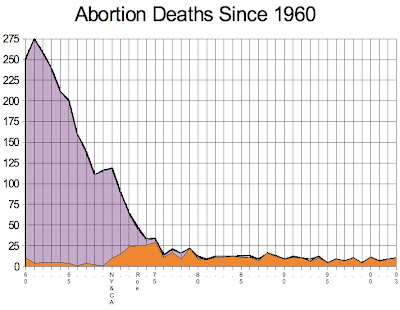Anna's abortion was typical of illegal abortions in that it was performed by a physician.
Davis had already been implicated in the 1913 abortion death of 27-year-old Anna Adler and the 1924 abortion death of 26-year-old homemaker Mary Whitney. On December 1, 1928, 23-year-old Esther V. Wahlstrom died from an abortion perpetrated by Davis, who was at last convicted for her crime. Clearly, merely criminalizing abortion is not sufficient to make sure that quacks are locked up where they can do no further harm. When Roe falls, it will be incumbent upon prolifers to close up loopholes in the law that allow abortionists to walk free after killing women.
Keep in mind that things that things we take for granted, like antibiotics and blood banks, were still in the future. For more about abortion in this era, see Abortion in the 1920s.
During the first two thirds of the 20th Century, while abortion was still illegal, there was a massive drop in maternal mortality, including mortality from abortion. Most researches attribute this plunge to improvements in public health and hygiene, the development of blood transfusion techniques, and the introduction of antibiotics. Learn more here.

Moving ahead to our supposedly more enlightened days of legal abortion:
Louchrisser Jackson, a 23-year-old mother of five, was 12 weeks pregnant when she went to Dr. Robert L. Gardner for a safe and legal abortion at Reproductive Services in Dallas on November 4, 1977. After the abortion, Louchrisser began hemorrhaging. Gardner said that he ordered blood for a transfusion, but it didn't arrive so about an hour before her death he attempted to give her a transfusion with his own blood -- which turned out to be an incompatible type.
A private ambulance was called but was not informed of the nature of the transport. In that jurisdiction, private ambulances are only permitted to transport stable patients; they are prohibited from responding to emergency calls. Because the ambulance service had no reason to expect an emergency, they did not respond promptly, nor did they refer the transport to the fire department's ambulance service. When the ambulance crew arrived, Louchrisser had gone into cardiac arrest. The crew, upon discovering that they'd been called for an emergency transport, rushed Louchrisser to the hospital immediately rather than calling for a fire department ambulance.
Louchrisser died that day. Gardner requested that the body be released without an inquiry. Another physician at the hospital learned of the case and requested an inquiry. The autopsy found massive hemmorage of at least two liters of blood, and a "1.8 x 2 cm. ragged perforation in the right lateral wall just above the internal os of the cervical canal. This perforation communicates freely with the retroperitoneal space on the right side. The endometrial surface of the uterus is ragged and hemorrhagic." Death was attributed to "massive retroperitoneal hemorrhage due to perforation of the uterus during a therapeutic abortion."
Abortion rights groups will claim that while Louchrisser's death was sad, there would be more abortion deaths like hers were abortion not "safe and legal." But as you can see from the graph below, abortion deaths were falling dramatically before legalization. This steep fall had been in place for decades. To argue that legalization lowered abortion mortality simply isn't supported by the data.

No comments:
Post a Comment